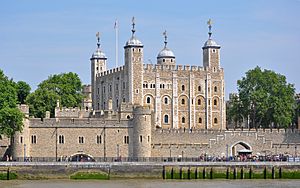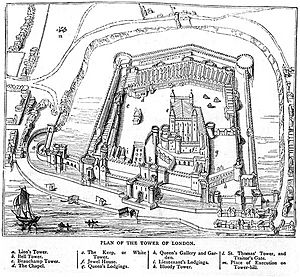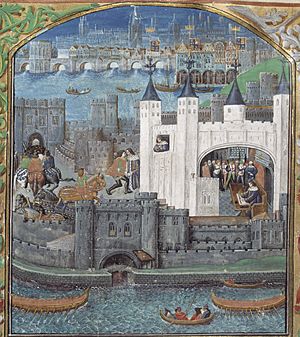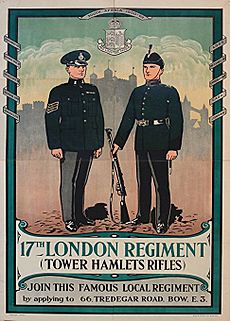Tower division facts for kids
The Tower Division was a special area in Middlesex, England. It was also known as the Tower Hamlets. This name came from the military duties people in the area owed to the Constable of the Tower of London. The word 'Hamlets' here meant parts of the Stepney area, not just small villages.
Today, this area covers much of inner East London. This includes the modern London Borough of Tower Hamlets. It also includes most of the London Borough of Hackney. For a long time, the Tower Division was seen as all of East London.
The Tower Division officially started in the 1600s. But the areas within it had shared military duties much earlier. This special area had its own courts and some local government powers. Its military role was very unique for its time.
Contents
A Special Area Like a "County within a County"
As more people moved near the City of London, the large area called Ossulstone Hundred was split. The Tower Division was one of these new parts. The others were Finsbury, Holborn, and Kensington.
The Tower Division was different from the others. It handled duties usually done by a larger area, like a county. This included legal, civil, and military tasks. This made the Tower Hamlets like a "county within a county." It was similar to the Ridings of Yorkshire.
Local Justice and Rules
The Tower Division had its own Justices of the Peace (JPs). These were like local judges. The Constable of the Tower chose them. They handled court cases and local government jobs. They often met at "quarter sessions."
JPs usually helped with many local tasks, such as:
- Fixing roads and bridges.
- Changing road paths.
- Building and keeping up county buildings.
- Managing county prisons.
- Watching over mental hospitals.
- Overseeing smaller local courts.
- Giving out licenses for public houses (pubs).
- Managing help for the poor (before 1834).
- Some duties with the local army (militia).
- The police force.
- Setting local taxes.
It's not fully clear how much power the Tower Division's JPs had over civil matters. But their military power was very strong.
Military Power and the Constable
The Tower Division was not under the main Lord Lieutenant of Middlesex. Instead, the Constable of the Tower had this power. He was often called the Lord Lieutenant of the Tower Hamlets. This started around 1605. The Constable's right to demand guard duty grew into raising a local army, the Tower Hamlets Militia.
Counties were the main way to raise armies back then. So, creating this special area meant East London had its own military unit. This made it separate from the county's main army.
Later, in 1855, the Metropolitan Board of Works was set up. This group managed big building projects in London. This likely reduced some of the JPs' duties. The Tower Division's special status ended in 1889. This was when the County of London was created. A new Lord Lieutenant was then chosen for the whole new county.
Military Duties of the Tower Hamlets
The Tower of London usually had a small group of guards called Yeoman Warders. But local men from the Hamlets, called Hamleteers, often helped guard it. The area also provided the Tower Hamlets Militia. This local army could be sent to fight if there was an invasion or rebellion.
Before the 1600s, England didn't have a standing army in peacetime. When regular army units were formed, they usually came from larger areas. But the Tower Hamlets did provide some regular soldiers.
Early Beginnings of Military Duty
The first record of Tower Hamlets people guarding the Tower of London is from 1554. This was during the time of Mary I. The Queen's advisors ordered men from the Hamlets to be ready to defend the Tower. This was before the official Tower Division was created. Since they were described as "owing" this service, it must have been a long-standing tradition.
Some historians think this duty started with William the Conqueror. Others believe it began later in the Middle Ages. This was when the Hamlets had more people. It's thought the duty came from the rules of the Manor of Stepney. This manor once covered most of the Hamlets area. The Constable of the Tower was also in charge of keeping up parts of the River Thames and River Lea.
Tower Hamlets units were at the Tilbury muster in August 1588. This was when Elizabeth I reviewed her troops. They were preparing to face the Spanish Armada. It was there that the Queen gave her famous Tilbury address.
How Many Soldiers?
The number of Hamleteers helping to guard the Tower changed a lot. In 1610, only 9 men were on duty each night. But in 1641, a very tense year, 552 Hamleteers guarded the Tower. They worked on a nine-night rotation. The number of men also varied by area. For example, Whitechapel provided 45 men on one night. On another, Hackney, Bow, Bromley-by-Bow, and Old Ford together provided 85.
The English Civil War
Before the War Started
Before the war, London and the eastern areas mostly supported Parliament. They were against King Charles I. The Tower Hamlets were especially strong supporters of Parliament. However, some poor people in Stepney wanted peace. They even tore down part of Parliament's defenses around London. But overall, support for Parliament stayed strong.
The Tower was very important because it held money and weapons. So, King Charles I made sure a loyal Constable, John Byron, was in charge. In late 1641 and early 1642, Byron brought in many weapons. Parliament reacted by putting a guard around the Tower. This was like a small siege. The London Trained Bands (a local army) did this, led by Philip Skippon.
Around January 20, 1642, the Constable went to Westminster to explain why he was gathering weapons. That night, with the Constable away, Skippon led 500 men of the London Trained Bands. They went quietly to the narrow streets of St Katharines district, near the Tower. Skippon's men approached the Iron Gate. This was a small gate outside the moat. The Tower was guarded by Hamleteers. But Skippon knew the Hamleteers supported Parliament. He thought he could convince them to let his men into the Tower. This would give Parliament control of the Tower.
Skippon asked the Sergeant at the Iron Gate to let them in. But the Sergeant refused. Skippon's force waited, hoping to talk him into it. He refused again. Skippon's men left when the Constable returned. It seemed that the Hamleteers' loyalty to their local duty was stronger than their political feelings. Skippon should have been punished for his actions, but Parliament quickly cleared him.
Before the war truly began, Parliament managed to get the King to appoint a Constable, Sir John Conyers, who supported them. The King then left London. The Tower became a very valuable asset for Parliament throughout the war.
Fighting in the War
In the early years of the English Civil War, both sides used local armies like the Tower Hamlets Militia. These forces usually stayed in their home areas. But the Tower Hamlets had a large "Trained Band." These were more motivated soldiers who trained often. They were willing to fight outside their home area. Later, they were organized into two regiments.
By early 1643, the Tower Hamlets forces joined those from Westminster and Southwark. They were all under the command of Philip Skippon. By 1644, the "regiment of the Tower Hamlets" had an estimated 2,000-3,000 men. Another reserve unit, the "Yellow regiment," also existed.
Under Skippon's leadership, the Tower Hamlets Trained Bands fought in several battles. These included Basing House (1643), Cropredy Bridge (1644), and Newbridge (1644). The Yellow regiment also fought at Bow Bridge in 1648, which was in their own area.
The flags of these regiments had different designs. Some showed the White Tower of London. They also showed the Traitors' Gate watergate. The soldiers wore special buff-colored sleeveless jackets. This showed they were a Trained Band, which meant they were higher-status soldiers than regular Militia.
The Fusiliers Army Unit
In 1685, during the Monmouth Rebellion, King James II created a new army unit. It was made from the Tower of London garrison and the Tower Hamlets Militia. This unit was first called the Ordnance Regiment. It was soon renamed the Royal Fusiliers. This name came from the "fusil," a type of musket they used. The Tower Hamlets Militia helped form this new regiment. Later, other Tower Hamlets reserve units would join this regiment.
The Royal Fusiliers became known by different names over time. Today, it is part of the Royal Regiment of Fusiliers. Its main office is at the Tower of London. The regiment also has a museum there.
Local Militia and Volunteers
Most local armies in the UK stopped being used in the early 1800s. But the Tower Hamlets Militia continued. By the late 1800s, it was known as the Tower Hamlets Militia (Queen's Own Light Infantry). It used the White Tower as its cap badge.
In 1857, there was a fear of invasion. This led to the creation of the Volunteer Force. This included Engineer and Rifle Volunteer Corps. In the Tower Hamlets, these new volunteers joined the existing militia.
These Volunteer units were started by local people. They needed permission from their county's Lord Lieutenant. But since Tower Hamlets was like a "county within a county," it had its own Lord Lieutenant (the Constable of the Tower). So, it could raise its own units.
Many units were created. One interesting example was the East Metropolitan RVC (11th Tower Hamlets). This unit was made up entirely of Jewish Volunteers. Many units were short-lived or combined with others. This can make their history a bit confusing.
The Cardwell Reforms of 1871 changed how volunteer armies were organized. They got more support from the government. The local engineer unit became the 2nd Tower Hamlets (East London) Engineer Volunteers.
The infantry units kept their local names. But they became reserve forces linked to a regular army regiment, The Rifle Brigade (The Prince Consort's Own). The Militia became the 7th Battalion. The 2nd Tower Hamlets Rifle Volunteer Corps became the 9th Battalion. The 1st Tower Hamlets Rifle Volunteer Brigade (THVRB) also joined this regiment. In 1881, these units became part of the East London Brigade for training.
The 1st Tower Hamlets Rifle Volunteer Brigade (THVRB) used the White Tower as its cap badge. They also used the Tower of London moat for training. Machine gun parts of this unit fought in the 2nd Boer War. They earned a battle honor at Colenso.
In 1904, the 1st Tower Hamlets Rifle Volunteer Brigade (THVRB) moved to the Royal Fusiliers regiment. This was a historic regiment first formed in 1685, mostly from Tower Hamlets men.
First World War Service
In 1908, London's reserve infantry units were reorganized. They formed a new London Regiment. But the Tower Hamlets units kept their local names and traditions. The 4th Bn Royal Fusiliers became the 4th Bn. The 9th Bn The Rifle Brigade (The Prince Consort's Own) became the 17th (County of London) Battalion, The London Regiment (Poplar and Stepney Rifles).
Both these units fought a lot in the First World War. The army needed more soldiers. So, the 4th (City of London) Battalion, London Regiment was "duplicated" into four battalions. The Poplar and Stepney Rifles were also "duplicated" into three battalions. The Tower Hamlets Engineers, now part of the Royal Engineers, were also very involved in the war.
In 1926, the Poplar and Stepney Rifles was renamed the 17th London Regiment (Tower Hamlets Rifles).
Second World War Service
In 1937, the London Regiment was ended. The Tower Hamlets Rifles moved back to The Rifle Brigade (The Prince Consort's Own) regiment. They fought in North Africa and Italy.
Air warfare became very important. So, the former 4th (City of London) Battalion, London Regiment, became an anti-aircraft unit. It was called the 60th (City of London) AA Brigade, RA (TA). This unit kept its Tower Hamlets identity. It fought at home and in Europe.
Units that came from the Tower Hamlets Engineers also played a big part in the war.
Cold War Era
After the war, the Tower Hamlets units lost their distinct names. This happened through several mergers.
The Tower Hamlets Rifles kept their local name the longest. They fought as infantry in the Second World War. Both their battalions (9th and 10th) merged in 1947. They became the 656th Light Anti-Aircraft Regiment, Royal Artillery (Tower Hamlets) TA. From 1961-1967, they were known as the 300th (Tower Hamlets) Light Air Defence Regiment RA (TA).
In 1967, another merger happened. This was the last Tower Hamlets unit in the British Army to keep the local name. Today, some British Army units recruit from wider areas. They still count Tower Hamlets units as part of their history.
Areas of the Tower Division
Different old records list the parts of the Tower Division. But its total area stayed the same. The Metropolitan Police Act 1829 listed the "parishes, townships, precincts and places" of the Tower Division. This was for including them in the Metropolitan Police District. The Militia (Tower Hamlets) Act 1796 said how many men each area should provide for the local army.
| Type | Name | Militia Men |
|---|---|---|
| parish | St Mary, Whitechapel | 132 |
| parish | Christchurch, Spitalfields | 78 |
| parish | St Leonard, Shoreditch | 155 |
| liberty | Norton Folgate | 31 |
| parish | St John, Hackney | 84 |
| parish | St Matthew, Bethnal Green | 122 |
| hamlet | Mile End Old Town | 57 |
| hamlet | Mile End New Town | 22 |
| parish | St Mary, Stratford Bow | 22 |
| parish | Bromley St Leonard | 6 |
| parish | All Saints, Poplar | 26 |
| parish | St Anne, Limehouse | 26 |
| hamlet | Ratcliff | 44 |
| parish | St Paul, Shadwell | 71 |
| parish | St John, Wapping | 45 |
| parish | St George in the East | 110 |
| liberty | East Smithfield | 45 |
| precinct | St Catherine | 11 |
| liberty | His Majesty's Tower of London consisting of: | |
| precinct | —Tower Within | — |
| precinct | —Old Tower Without | 5 |
| liberty | —Old Artillery Ground | 11 |
| parish | —Minories Holy Trinity | 8 |
| precinct | —Wellclose | 9 |
Namesakes: How the Name Lives On
Old Parliamentary Area
From 1832 to 1885, there was a special area for Parliament called "Tower Hamlets." It was named after the Tower Division. From 1832 to 1868, it had the same borders as the Tower Division. A well-known Member of Parliament (MP) for this area was Joseph d'Aguilar Samuda. He was a shipbuilder and an officer in the local army. After 1868, the area's population grew. So, the constituency was split into two. The southern part kept the name Tower Hamlets. The northern parts, like Hackney and Shoreditch, became part of a new Hackney constituency. The southern Tower Hamlets constituency lasted until 1885.
Modern Tower Hamlets Borough
The name "Tower Hamlets" was used again in 1965. This was for the modern London Borough of Tower Hamlets. This new borough was created from the southern parts of the old Tower Division.
The Shoreditch and Hackney areas of the old Tower Division now make up most of the modern London Borough of Hackney.





